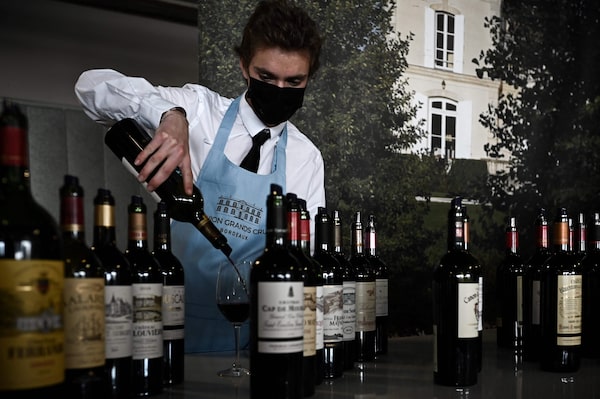
A man serves a glass of wine during the official 'Semaine des Primeurs' in Bordeaux, southwestern France, on April 25.PHILIPPE LOPEZ/AFP/Getty Images
For more wine advice and reviews, recipes, restaurant news and more, sign up to receive our Good Taste newsletter in your inbox every Wednesday.
The popular image of Bordeaux is stately chateaux and opulent, full-bodied red wines that count themselves among the world’s finest. While that’s true to an extent, it’s not necessarily the norm.
This week a party of Globe and Mail readers, writers and editors are busy touring Bordeaux, exploring its regions and catching up with the realities of a historic wine trade where everyone wants to step up.
Unlike the handful of top estates, such as Cos d’Estournel, Lafite and Margaux, not all 8,800 of the registered wine-producing chateaux are what you might call stately or stunning.
Beyond the picturesque mansions or majestic turreted castles seen in articles and picture books, there are many more rustic manors or hunting lodges as well as faded country homes. There are also numerous buildings whose crumbling countenances would be wistfully described in a real estate listing as fixer-uppers or worse: a handyperson’s dream. Some have no meaningful accommodations whatsoever; remember château is a mere marketing term to add prestige to its vineyards and production facilities.
And then there’s the distorted view of the wines produced. More than 80 per cent of the wine produced in Bordeaux’s 2020 vintage was red, but not all of it was opulent, full-bodied or age worthy. (The vintage also produced 10 per cent dry white, 4.5 per cent rosé and 1 per cent sweet whites, which continue to be a labour of love for producers in Sauternes and environs along the Garonne and tributary rivers that craft minuscule quantities of truly magical wines that struggle for attention.)
Most of the production is modest, medium-bodied reds sold as Bordeaux and Bordeaux Supérieur, which command affordable prices, often between $15 and $30 a bottle. To my taste, the best offers the everyday pleasure many wine lovers are looking for, at prices that aren’t out of reach for the majority. However, Bordeaux’s stodgy reputation keeps them off some liquor store shelves, and wine lists run by young and hip sommeliers with an eye for promoting new discoveries.
But there’s plenty of new to be found in a region that has quickly developed infrastructure to host wine tourists and keep them engaged. Twenty years ago, Bordeaux would largely operate by invitation only. Wine agents and journalists were welcome, but Napa and even Niagara and the Okanagan were better suited to promoting tourism.
Some stories I am watching: sweet wine producers are slowly increasing their production of dry white wines, citing a need to develop interest amongst new and younger consumers. A growing number of chateaux are running bed and breakfasts and/or restaurants on the property to encourage guests to stay longer and become bigger brand ambassadors for their wines.
An increasing number of estates are embracing organic and biodynamic practices in the vineyards, with the likes of Fleur Cardinale, Lafite Rothschild and Pichon Comtesse undergoing full conversions to organics. The conversion takes three years, after which time the operations will be certified as organically farmed.
Last year, Australia’s Treasury Wine Estates acquired more properties in Bordeaux, namely Château Belle-Vue, Château Gironville and Château Bolaire, which join Château Cambon la Pelouse and Château Trois Moulins bought in 2019. Following in the wake of Penfolds recent California collection, it seems only a matter of time before Bordeaux wines bearing the name Penfolds are released.
E-mail your wine and spirits questions to The Globe. Look for answers to select questions to appear in the Good Taste newsletter and on The Globe and Mail website.